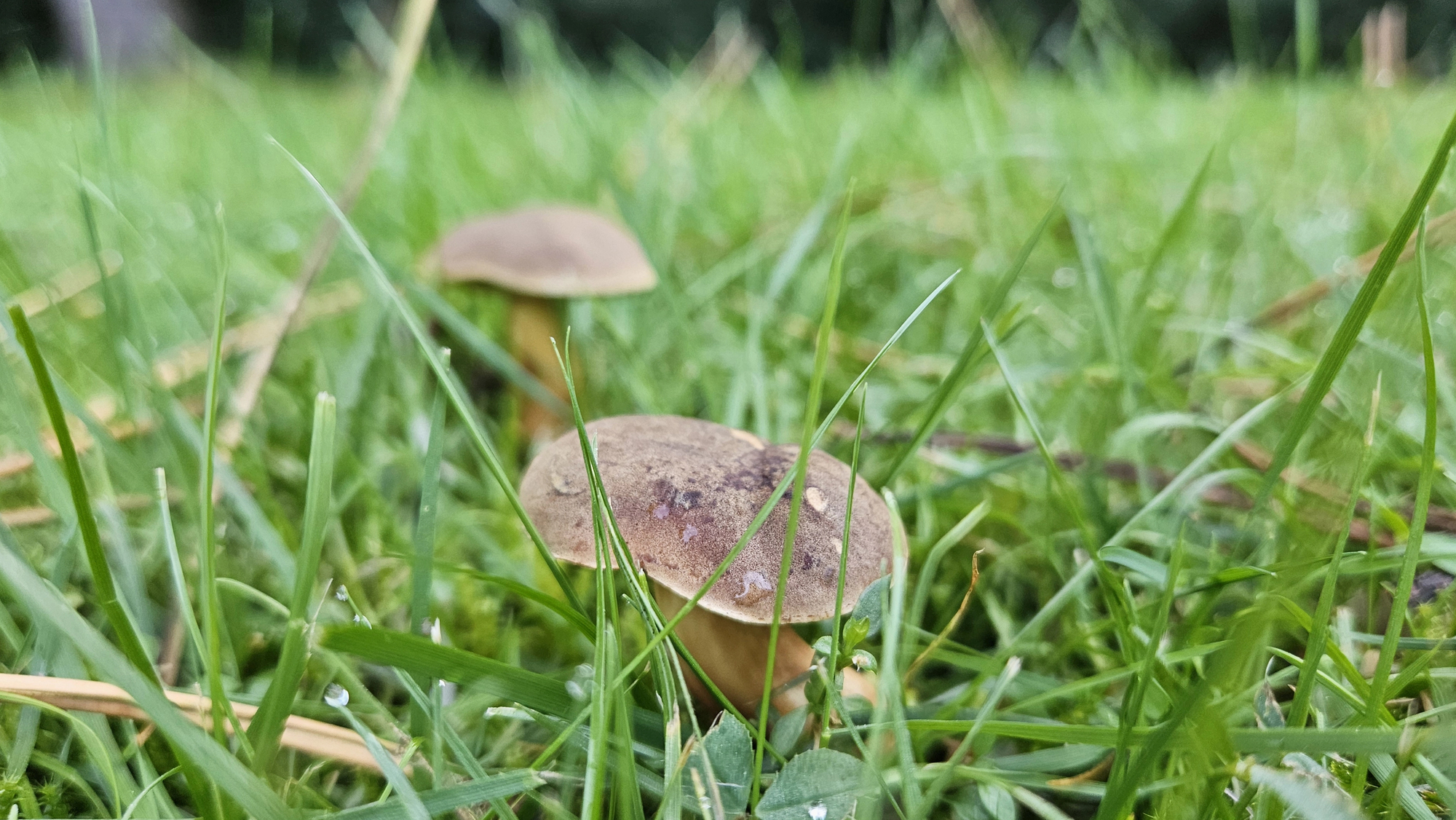Keeping a healthy lawn can sometimes feel like a never-ending battle against pests and diseases. Fungal infections are among the most common lawn problems faced by gardeners, often appearing suddenly and spreading quickly across your grass. Recognising the early signs of fungal lawn diseases such as brown patches, discoloured rings, or powdery substances on grass blades allows you to intervene before extensive damage occurs.
Fungal spores exist naturally in most garden environments, waiting for the right conditions to flourish. These conditions typically include excess moisture, poor air circulation, and temperature fluctuations that stress your lawn. Spring and autumn tend to be particularly problematic periods as the combination of moisture and moderate temperatures creates an ideal environment for fungal growth.
Key Takeaways
- Early detection signs include unusual patches, discolouration, and visible fungal growth on grass blades.
- Most lawn fungi thrive in damp, poorly drained areas with limited sunlight and air circulation.
- Regular maintenance practices like proper watering, aeration and appropriate mowing heights significantly reduce the risk of fungal infections.
Understanding Fungal Lawn Diseases
Fungal lawn diseases affect grass health through microscopic organisms that spread through spores and thrive in specific environmental conditions. These infections can quickly damage or kill grass if not identified and treated early.
Common Types of Fungal Lawn Diseases
Brown patch appears as circular brown areas 15-30 cm in diameter, primarily affecting fescue and ryegrass during warm, humid weather. The patches often have a smoke-ring appearance with darker borders.
Dollar spot creates small, straw-coloured patches about the size of a silver dollar. These patches may merge to form larger affected areas, particularly in Kentucky bluegrass and fine fescues.
Red thread is identified by pinkish-red threads extending from grass blades, most commonly attacking perennial ryegrass and fescues during cool, wet conditions.
Fairy rings form distinct circular patterns of either darker green grass, mushrooms, or dead grass. They develop as fungi decompose organic matter below the soil surface.
Rust appears as orange-yellow pustules on grass blades, creating a rusty appearance when touched. It typically develops during warm days with cool nights and extended periods of dew.
Causes and Contributing Factors
Poor drainage creates damp conditions that fungi need to flourish. Standing water or consistently wet soil provides the perfect environment for spore germination.
Improper mowing practices, such as cutting grass too short, can stress turf and make it vulnerable to fungal infections. Maintaining proper mowing height increases grass resilience.
Temperature and humidity play significant roles in fungal development. Most lawn fungi thrive in temperatures between 15-30°C with high humidity levels.
Excessive nitrogen fertilisation can trigger rapid, weak growth that’s susceptible to disease. Balanced fertilisation based on soil testing helps prevent this problem.
Thatch buildup exceeding 1.3 cm creates a breeding ground for fungi. This layer of dead grass material retains moisture and blocks water and nutrients from reaching roots.
Life Cycle of Lawn Fungi
Fungi begin as dormant spores that activate when environmental conditions become favourable. These spores may reside in soil, thatch, or plant debris for extended periods.
The infection phase starts when active spores contact grass blades or roots. Entry often occurs through natural openings or wounds in the plant tissue.
Fungal growth accelerates as mycelia (fungal threads) spread through plant tissues. This phase causes visible symptoms as the fungi extract nutrients from the grass.
Sporulation occurs when the fungi produce new spores for reproduction. These appear as visible fruiting bodies, powder, or slime on grass surfaces and can spread to healthy areas through wind, water, or lawn equipment.
The cycle continues as new spores disperse and remain dormant until conditions favour growth again. This persistent cycle explains why fungal infections often recur without proper treatment.
Early Identification of Fungal Lawn Problems
Spotting fungal issues in your lawn at an early stage allows for quicker treatment and reduces long-term damage. Most fungal diseases have distinct visual markers that become apparent before the infection spreads throughout the entire lawn.
Recognising the First Signs of Fungal Infection
Brown spots are often the first indication of fungal problems in lawns. These spots may start small, perhaps 5-10cm in diameter, before expanding outward. Look for discoloured patches that appear different from normal drought stress or dog urine damage.
Morning inspections are ideal as many fungi produce spores overnight. Check for white, grey, or pinkish growths on grass blades, especially after periods of high humidity or rainfall.
Thinning grass in specific areas without obvious cause may signal an underground fungal problem affecting the root system. Pull gently on affected grass – if it comes up easily with damaged roots, fungi may be present.
Examine grass clippings after mowing affected areas. Infected blades often show discolouration, spots, or unusual markings that aren’t visible from standing height.
Symptoms by Disease Type
Dollar Spot: Small, straw-coloured circular patches (2.5-10cm). Affected blades display distinctive tan lesions with reddish-brown borders. Most active in spring and autumn when nights are cool and dew persists.
Brown Patch: Circular areas of dead grass surrounded by a dark “smoke ring” border, particularly in warm, humid weather. Patches can grow to 1m in diameter within days. Common in heavily fertilised lawns.
Red Thread: Pink or reddish threads growing from leaf tips, creating a pinkish haze across the lawn. Yellow patches gradually turn brown as the disease progresses.
Fusarium Patch (Snow Mould): Circular grease spot-like patches (7.5-30cm) with orange-brown borders. White-pink cottony growth appears in damp conditions.
| Disease | Key Visual Signs | Optimal Conditions |
|---|---|---|
| Dollar Spot | Small tan circles with hourglass lesions | Cool, moist nights |
| Brown Patch | Large circles with smoke rings | Hot, humid weather |
| Red Thread | Pink/red threads, hazy appearance | Cool, wet conditions |
| Fusarium | Grease-like spots, cottony growth | Cold, damp weather |
Differentiating from Other Lawn Issues
Fungal infections can be mistaken for other common lawn problems. True fungal issues typically display irregular patterns rather than the uniform damage caused by drought or improper mowing.
Pet urine typically creates isolated yellow patches with very green borders, unlike the spreading patterns of fungi. Insect damage usually shows signs of physical destruction like chewed blades or visible pests.
Water test areas of concern by applying a small amount of water. Drought-stressed areas generally recover quickly, while fungal infections remain unchanged or worsen with added moisture.
Check for spores or fungal growth using a magnifying glass. Most fungi produce visible structures on infected blades that distinguish them from nutrient deficiencies.
Note the timing and weather conditions. Many fungi emerge during specific seasonal transitions or after certain weather patterns, providing clues to differentiate them from mechanical or chemical damage.
Favourable Conditions for Disease Development
Fungal lawn diseases thrive under specific environmental conditions that weaken grass and allow pathogens to flourish. Understanding these conditions helps homeowners take preventative action before diseases take hold.
Weather and Environmental Stressors
Temperature and moisture levels play critical roles in fungal development. Most lawn fungi become active when temperatures range between 15-30°C, with different diseases having specific temperature preferences.
Humidity factors:
- High humidity (above 80%) creates ideal conditions for spore germination
- Extended leaf wetness periods (6+ hours) significantly increase infection risks
- Morning dew that persists throughout the day provides constant moisture
Environmental stress weakens grass defences. Drought-stressed lawns become susceptible when suddenly exposed to heavy rainfall. Heat stress during summer months can make cool-season grasses particularly vulnerable to fungal attacks.
Seasonal changes often trigger disease outbreaks as temperature and moisture conditions shift rapidly. Spring and autumn typically see higher disease pressure due to moderate temperatures combined with increased rainfall.
Soil and Drainage Factors
Poor soil conditions create environments where fungi can easily establish and spread. Compacted soil restricts root growth and limits water movement, creating wet patches where fungi thrive.
Problematic soil conditions:
- Clay-heavy soils that retain excess water
- Compacted areas with limited oxygen circulation
- Nutrient imbalances, especially excessive nitrogen
- Incorrect soil pH (outside 6.0-7.0 range)
Inadequate drainage leads to standing water, which fungi require for reproduction. Low-lying areas of lawns often develop diseases first as water pools there after rainfall.
Over-watering, particularly in evening hours, extends leaf wetness periods. Proper irrigation timing is essential—watering early morning allows grass to dry before nightfall, reducing fungal growth opportunities.
Impact of Thatch and Shade
Excess thatch creates a humid microenvironment between soil and grass that harbours fungal pathogens. When thatch exceeds 1.3 cm in depth, it absorbs moisture like a sponge and prevents proper air circulation.
Decomposing thatch provides nutrients that feed certain fungi. The organic matter in thatch becomes a food source, particularly for diseases like red thread and dollar spot.
Shade problems affecting lawns:
- Reduced sunlight slows drying after rain or irrigation
- Lower photosynthesis rates weaken grass plants
- Poor air movement in sheltered areas maintains humidity
- Cooler temperatures in shaded areas favour certain fungi
Dense plantings near lawns restrict air movement. Trees, shrubs and structures that block morning sun keep grass wet longer, creating perfect conditions for fungi to spread throughout vulnerable turf areas.
Effective Treatment Methods for Fungal Lawn Diseases
Treating fungal lawn diseases requires a combination of proper cultural practices and carefully selected fungicides. Early intervention and proper application methods significantly increase success rates.
Cultural and Maintenance Practices
Proper lawn care forms the foundation of fungal disease management. Adjusting your mowing height can have a dramatic effect on lawn health – never remove more than one-third of the grass blade in a single mowing session. Taller grass develops deeper root systems that better withstand disease pressure.
Watering practices greatly impact fungal development. Water deeply but infrequently, preferably in early morning hours. This allows leaf surfaces to dry during the day, creating conditions unfavourable to fungal growth.
Aeration and scarifying are essential maintenance techniques. These practices reduce thatch buildup where fungi thrive and improve soil drainage. Consider aerating your lawn annually, especially in high-traffic areas.
Proper fertilisation also plays a key role. Excessive nitrogen can trigger certain fungal outbreaks, so follow recommended application rates. Balanced nutrition strengthens grass’s natural defences against disease.
Proper Fungicide Application
Fungicides should be considered after cultural practices have been optimised. Select products specifically labelled for your identified lawn disease. Broad-spectrum fungicides work against multiple diseases but targeted options may provide better results.
Always follow label instructions precisely. Incorrect application rates waste money and may damage grass or prove ineffective against the target fungi.
Timing is critical for fungicide success. Apply preventative treatments before conditions favour disease development. For brown patch control, apply when night temperatures consistently reach 18°C.
Rotation between different fungicide classes prevents resistance development. Most fungi can adapt to chemical controls over time, so avoid using the same product repeatedly.
Consider environmental impact when selecting fungicides. Many golf courses now use less toxic alternatives that protect beneficial soil organisms while still controlling disease.
When to Seek Professional Help
Professional lawn care services become necessary when disease persists despite proper cultural practices and fungicide applications. Experts have access to professional-grade fungicides and application equipment not available to homeowners.
Persistent or severe infestations often indicate underlying soil or drainage problems that require specialised knowledge. Professional soil testing can identify nutrient imbalances contributing to disease susceptibility.
Lawn care professionals can implement integrated pest management strategies that minimise fungicide use while maximising control. They can also provide customised maintenance plans addressing your lawn’s specific needs.
Consider professional help if your lawn requires treatments that might harm neighbouring plants or water sources. Professionals are trained to apply products safely and in compliance with local regulations.
Preventing Future Fungal Outbreaks
Prevention is more effective than treatment when it comes to fungal lawn diseases. Proper lawn care practices can significantly reduce the risk of fungal problems and create an environment where healthy grass outcompetes potential pathogens.
Optimising Watering and Irrigation
Water management is the cornerstone of fungal disease prevention. Most lawn fungi thrive in moist conditions, making proper irrigation essential for disease control.
Water deeply but infrequently, allowing the soil to dry slightly between waterings. This encourages deeper root growth and reduces leaf wetness duration. Aim for 2.5-4 cm of water per week, adjusted for rainfall.
Time your watering wisely. Early morning (4-7 am) is ideal as it allows grass to dry throughout the day, minimising fungal growth opportunities. Evening watering leaves grass wet overnight, creating perfect conditions for disease development.
Consider installing smart irrigation systems with rain sensors or soil moisture monitors. These technologies help maintain optimal soil moisture while preventing overwatering and water waste.
For sloped areas or clay soils, use cycle-and-soak methods to prevent runoff and ensure water penetrates deeply into the soil profile.
Mowing and Clipping Management
Proper mowing practices play a vital role in preventing fungal outbreaks. Maintain grass at the upper end of its recommended height range to promote deeper root systems and increased stress tolerance.
Never remove more than one-third of the grass blade height in a single mowing. Cutting too short stresses the grass, making it more susceptible to disease. Different grass types require different heights—perennial ryegrass thrives at 5-7 cm, whilst bentgrass performs best at 0.5-2 cm, and tall fescue at 7-10 cm.
Keep mower blades sharp to create clean cuts that heal quickly. Dull blades tear grass, creating entry points for fungal pathogens and increasing water loss.
Remove grass clippings when disease is present to prevent spread. In healthy lawns, mulching clippings can return valuable nutrients to the soil, but infected clippings can spread spores throughout the lawn.
Vary your mowing pattern each time to prevent soil compaction and encourage upright growth.
Fertilisation and Nutrient Balance
Balanced nutrition strengthens grass against fungal infections. Conduct soil tests annually to identify nutrient deficiencies and determine exact fertilisation needs.
Apply nitrogen fertiliser cautiously. Too little nitrogen leaves grass weak and vulnerable, whilst excessive amounts can trigger rapid, succulent growth prone to fungal attack. For most cool-season grasses like perennial ryegrass, apply 0.5-1 kg of nitrogen per 100 square metres annually, divided into several applications.
Time fertilisation strategically. Avoid high-nitrogen feeds during hot, humid weather when fungi spread rapidly. Instead, focus main fertilisation during active growth periods (spring and autumn for cool-season grasses).
Balance nitrogen with appropriate potassium levels. Potassium enhances disease resistance without promoting excessive growth. A ratio of 3:1:2 (N-P-K) works well for most established lawns.
Consider slow-release fertilisers to provide steady nutrition without growth surges that attract fungal pathogens.
Building Lawn Resilience
A resilient lawn naturally resists fungal invasion. Start with disease-resistant grass varieties suited to your local conditions. Many improved cultivars of perennial ryegrass, tall fescue and bentgrass offer enhanced resistance to common fungal diseases.
Reduce shade where possible. Prune tree branches and thin shrubs to improve air circulation and sunlight penetration. Grasses in full sun dry faster after rain or watering, limiting fungal development.
Address soil compaction through core aeration. This process improves root growth, water penetration and gas exchange, creating healthier grass plants that better withstand disease pressure.
Maintain proper soil pH between 6.0-7.0 for most lawn grasses. Fungi often thrive in highly acidic or alkaline conditions that stress grass plants.
Consider applying beneficial fungi like mycorrhizae to establish a healthy soil microbiome that competes with pathogenic fungi. These beneficial organisms form symbiotic relationships with grass roots, improving nutrient uptake and disease resistance.





